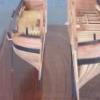MORE HANDBOOKS ARE ON THEIR WAY! We will let you know when they get here.
×
-
Posts
1,056 -
Joined
-
Last visited
Reputation Activity
-
 grsjax got a reaction from Canute in Tools and techniques used in the 18th Century
grsjax got a reaction from Canute in Tools and techniques used in the 18th Century
lots of experience and patience were the major tools used.
-
 grsjax got a reaction from Canute in Power Tools for a Fully Framed Build
grsjax got a reaction from Canute in Power Tools for a Fully Framed Build
As said the price of chisels and planes has a relationship to the quality. However what is important is the quality of the steel used. I purchased a set of cheap chisels to use for rough work and found that although the finish was poor the steel was very good. After reworking the cutting edges and sharpening they turned out to be very good chisels. The set of 5 chisels cost me about $5 at HF on sale. Take away here is that if you are on a budget and willing to do some work on the chisels and plane irons you can get some decent tools at low cost.
-
 grsjax got a reaction from mtaylor in Power Tools for a Fully Framed Build
grsjax got a reaction from mtaylor in Power Tools for a Fully Framed Build
As said the price of chisels and planes has a relationship to the quality. However what is important is the quality of the steel used. I purchased a set of cheap chisels to use for rough work and found that although the finish was poor the steel was very good. After reworking the cutting edges and sharpening they turned out to be very good chisels. The set of 5 chisels cost me about $5 at HF on sale. Take away here is that if you are on a budget and willing to do some work on the chisels and plane irons you can get some decent tools at low cost.
-
 grsjax got a reaction from jud in Power Tools for a Fully Framed Build
grsjax got a reaction from jud in Power Tools for a Fully Framed Build
As said the price of chisels and planes has a relationship to the quality. However what is important is the quality of the steel used. I purchased a set of cheap chisels to use for rough work and found that although the finish was poor the steel was very good. After reworking the cutting edges and sharpening they turned out to be very good chisels. The set of 5 chisels cost me about $5 at HF on sale. Take away here is that if you are on a budget and willing to do some work on the chisels and plane irons you can get some decent tools at low cost.
-
 grsjax got a reaction from dgbot in Power Tools for a Fully Framed Build
grsjax got a reaction from dgbot in Power Tools for a Fully Framed Build
As said the price of chisels and planes has a relationship to the quality. However what is important is the quality of the steel used. I purchased a set of cheap chisels to use for rough work and found that although the finish was poor the steel was very good. After reworking the cutting edges and sharpening they turned out to be very good chisels. The set of 5 chisels cost me about $5 at HF on sale. Take away here is that if you are on a budget and willing to do some work on the chisels and plane irons you can get some decent tools at low cost.
-
 grsjax got a reaction from Canute in Power Tools for a Fully Framed Build
grsjax got a reaction from Canute in Power Tools for a Fully Framed Build
All true. However there is a big difference between a Harbor Freight machine and LMS or MM machine. The difference is in the quality control. The Sieg factory will manufacture a lathe or mill to what ever level of precision a customer wants. HF buys run of the factory machines that may or may not have been assembled and checked adequately. MM and LMS buy machines manufactured to their specs and check the QC themselves resulting in a much better product. Not to say these machines can't be improved but out of the box they are pretty good. My MM lathe has hand scraped ways and came needing only minor adjustments to be up and running.
Your observation that you always need a bigger machine for something is very true. That said it is a good idea to get a machine that will both do precision work and can handle larger pieces (with in reason). I don't think I could reliably do 1/10000" work on my lathe but with the proper setup I could handle 5/10000". But then how often do you need that kind of precision? 1/1000" difference is to small to see with the naked eye and would be more than adequate for model building.
Another thing I like about the larger machines is that you can easily modify them to improve performance. Low cost mods like swapping the roller bearings in the head stock for tapered roller bearings is an example. Also the Seig 7x lathes can cut left handed threads and with a few extra change gears can cut threads from 4/in to 240/in. I haven't seen any of the small machines that can do either.
An alternative to the Seig lathes are the older Atlas/Craftsman 6" lathes. They can be found for sale (at least here in the states) for reasonable prices.
-
 grsjax got a reaction from Canute in Power Tools for a Fully Framed Build
grsjax got a reaction from Canute in Power Tools for a Fully Framed Build
Size but also power. A Sieg 2x mill, which is what both the MM and LMS machines start as, can handle cuts in hard materials that a small machine like the Sherline or Proxxon simply cannot do. If all you are ever going to do is take light cuts on soft brass, aluminum and wood one of the smaller machines will work fine. If you want to work in steel, cast iron or even some of the really hard woods like ebony you want a machine that can do the job faster and easier.
For making small parts for a model I guess it really isn't important but when it comes to making jigs and special tools you will want the size and power of the larger machine.
Same applies to the lathes.
-
 grsjax got a reaction from Canute in Power Tools for a Fully Framed Build
grsjax got a reaction from Canute in Power Tools for a Fully Framed Build
Excellent mill. There lathe is also very good.
Chinese lathes and mills can be pretty bad but if you get one from a reputable dealer like Micromark or Little Machine Shop you will be getting a good machine. In addition the Chinese machines will be far more capable than the sherline, taig or proxxon products.
-
 grsjax got a reaction from tkay11 in Tools and techniques used in the 18th Century
grsjax got a reaction from tkay11 in Tools and techniques used in the 18th Century
lots of experience and patience were the major tools used.
-
 grsjax got a reaction from mtaylor in Tools and techniques used in the 18th Century
grsjax got a reaction from mtaylor in Tools and techniques used in the 18th Century
lots of experience and patience were the major tools used.
-
 grsjax reacted to michaelpsutton2 in Sail Plan for British brig sloop
grsjax reacted to michaelpsutton2 in Sail Plan for British brig sloop
The dimesions of the seagull class are smaller than the Cruizers. I would use steels book and calculate
-
 grsjax reacted to wefalck in Power Tools for a Fully Framed Build
grsjax reacted to wefalck in Power Tools for a Fully Framed Build
Depends what you are doing, but I couldn't live without a lathe anymore. With a vertical slide you can even do small and light milling jobs. Apart from the hand-held power-drill that costs very little these days, a lathe (with collets) would be on top of my list, if I would start out fresh.
-
 grsjax reacted to Gaetan Bordeleau in Power Tools for a Fully Framed Build
grsjax reacted to Gaetan Bordeleau in Power Tools for a Fully Framed Build
Size for a lathe or a mill in model ship building is not a matter because you work on woods mainly and on few occasions on brass .
Proxxon is the only one that I know who qualify for Speed for the mills because of the speed. Of course you can mill at 5000 rpm but in comparison
it is like finishing at #80 in comparison with #600, wood particles will also be smaller and it will chip less.
Unless you want to mill aluminum or harder materials, tool room machines are not required.
The difference between a miniature lathe and a toolroom lathe is a pass of .001'' in comparison of .01'', 10 times faster
A mill is not really necessary, you can easily go without it. To use it to make notches is not a real good thing, it needs a longer time to do it because it leaves round corners, it faster to do it by hand only.
For the lathe it is a different story; it would be harder to go without a lathe for a model ship builder, the cheapest alternative being to use a drill.
-
 grsjax reacted to wefalck in making chainplates or readymade
grsjax reacted to wefalck in making chainplates or readymade
A different, though perhaps somewhat more expensive route would be to have them etched. Perhaps there are other parts you could do at the same time. Perhaps you could share the cost with other builders by having several copies done.
Drilling into sheet brass can difficult with helical drill can be difficult, as the standard drills tend to 'catch'. There are special drills for brass that have a steeper helix and are ground differently. Another option are spade drills as traditionally used by watchmakers for the purpose. They can be obtained from watchmakers and jewellers supply houses.
Watchmakers also used to make spade drills themselves, but this needs a bit of practice (which they would have acquired during their apprenticeship).
-
 grsjax reacted to dgbot in Power Tools for a Fully Framed Build
grsjax reacted to dgbot in Power Tools for a Fully Framed Build
I have found the Sherine more than adequate. for what I have done. From brass ,wood, to steel. As was stated before it is not designed for heavy production . I remember a rush job where we had to work some steel. However our LeBlond blew something so they asked me to work on it at home. I was able to turn it to shape but the job took awhile. The Leblond had the power where I could hog the material quite a bit to save time. On the Sherline I had to take minot cuts to get the job done. Remember this is a hobby for pleasure. and The tools you use will do the job if you take your time and learn how to use them efficiently. As Tim Allen would say MORE POWER not
David B
-
 grsjax got a reaction from mtaylor in Power Tools for a Fully Framed Build
grsjax got a reaction from mtaylor in Power Tools for a Fully Framed Build
All true. However there is a big difference between a Harbor Freight machine and LMS or MM machine. The difference is in the quality control. The Sieg factory will manufacture a lathe or mill to what ever level of precision a customer wants. HF buys run of the factory machines that may or may not have been assembled and checked adequately. MM and LMS buy machines manufactured to their specs and check the QC themselves resulting in a much better product. Not to say these machines can't be improved but out of the box they are pretty good. My MM lathe has hand scraped ways and came needing only minor adjustments to be up and running.
Your observation that you always need a bigger machine for something is very true. That said it is a good idea to get a machine that will both do precision work and can handle larger pieces (with in reason). I don't think I could reliably do 1/10000" work on my lathe but with the proper setup I could handle 5/10000". But then how often do you need that kind of precision? 1/1000" difference is to small to see with the naked eye and would be more than adequate for model building.
Another thing I like about the larger machines is that you can easily modify them to improve performance. Low cost mods like swapping the roller bearings in the head stock for tapered roller bearings is an example. Also the Seig 7x lathes can cut left handed threads and with a few extra change gears can cut threads from 4/in to 240/in. I haven't seen any of the small machines that can do either.
An alternative to the Seig lathes are the older Atlas/Craftsman 6" lathes. They can be found for sale (at least here in the states) for reasonable prices.
-
 grsjax reacted to wefalck in Power Tools for a Fully Framed Build
grsjax reacted to wefalck in Power Tools for a Fully Framed Build
As I suggested above, perhaps the administrators start a sort of permanent file, where one can compare the different capabilities and capacities. I agree, for making jigs and attachments for your machines, a bigger machine would be handy. But you will find that is always a 'catch 22' - you always better have a bigger machine for making attachments for your smaller machine. But, how did they do in the old days, when there were no bigger and more precise machines ? Sometimes it just need ingenuity and patience and you can turn out good stuff with smaller machines. As said earlier, if you can't have a range of machines, you have to make a trade-off between your needs.
In principle, a big machine is more stable, has less vibrations and, therefore, the potential for higher precision. This, however, requires that it is well-made and well-adjusted. The problem is that adjustment costs time and, hence, money. This is were the Chinese makers cut corners in order to be able to sell their products at competitive prices. Compare a modern-day Chinese mill or lathe with a precision machine of the 1940s or 1950s (the pre CN- and CNC-age) coming from Switzerland. On the latter the slides move like silk in spite of the large masses involved, because the ways have been scraped-in and not just milled. In order to get equivalent handling for working on small parts, you have to opt for a smaller machine - unless you are a master in machine adjustment.
BTW, I am working steel on my watchmaking lathes and mills. It is a pain at times and takes a long time because I can only take light cuts, but with perseverance I manage to most things I want to do. The same machine, on the other hand, is ways better than a big Chinese machine will be, on small parts. With careful adjustment, the Sherline or Proxxon machines are almost as good.
-
 grsjax got a reaction from mtaylor in Power Tools for a Fully Framed Build
grsjax got a reaction from mtaylor in Power Tools for a Fully Framed Build
Size but also power. A Sieg 2x mill, which is what both the MM and LMS machines start as, can handle cuts in hard materials that a small machine like the Sherline or Proxxon simply cannot do. If all you are ever going to do is take light cuts on soft brass, aluminum and wood one of the smaller machines will work fine. If you want to work in steel, cast iron or even some of the really hard woods like ebony you want a machine that can do the job faster and easier.
For making small parts for a model I guess it really isn't important but when it comes to making jigs and special tools you will want the size and power of the larger machine.
Same applies to the lathes.
-
 grsjax reacted to wefalck in Power Tools for a Fully Framed Build
grsjax reacted to wefalck in Power Tools for a Fully Framed Build
This seems to be a recurrent topic. Perhaps the administrators could/should create a permanent space, where the pros and cons of different types (not makes !!) of machines can be laid down.
-
 grsjax reacted to RussR in Power Tools for a Fully Framed Build
grsjax reacted to RussR in Power Tools for a Fully Framed Build
I thank it all depends on how much one has to spend on there "hobby".
When I was working to make my living, I bought the best tools. But this is a hobby, not something most of us make our living at. This is new to me at the present but I have bought two power tools that some would call "crap". But as an amateur I find that they do an acceptable job for the occasional use. I have seen some beautiful work on MSW by people that didn't have the best tools that money could buy.
Which reminds me of a thread on MSW. A member was inquiring about a low cost rope walk. And the response was "its crap" and recommended another (high dollar) rope walk. And Chuck responded that he makes all of his rope with a modified rope walk that the member was inquiring about. I think most of us know the quality of the work Chuck puts out.
Like it is said "the difference between men and boys is the price of there toys".
But if you still have money for groceries, utilities and health care, go for it.
Russ (wannabe amateur ship modeler)
-
 grsjax reacted to wefalck in Power Tools for a Fully Framed Build
grsjax reacted to wefalck in Power Tools for a Fully Framed Build
Again this is a recurrent discussion ... the epical dock-yard models were made without power-tools available, they were simply not invented then. (Almost) everything can be made with hand-tools, given the necessary dexterity and patience. Power-tools (not the hand-held ones) have the advantage of controlled movements - you work in a Carthesian space and need to worry only about movements along one axis at a time - much easier for many of us. Often power-tools also save elbow-grease, of course.
OK, this was rather philosophical. On a more practical level, you need to know what kind of materials you anticipate to work with. Wood, metal, and plastics all have quite different machining properties and require (often) specific tools. Wood requires much higher cutting-tool speeds than metals. This can be a serious limitation, when thinking of using a metal-lathes for working on wood. Most mills run only at around 5000 rpm, which is too slow for the small cutter you are like to use. The only mill I know of that has rpms adequate for wood is the smallest PROXXON. There you run into capacity problems, because the slide travels are rather limited. It would be ok for making small parts, but could pose a problem, when you want notch keels or something like this on largeish models. There will be alsway a trade-off.
-
 grsjax reacted to mtaylor in Power Tools for a Fully Framed Build
grsjax reacted to mtaylor in Power Tools for a Fully Framed Build
John,
Light and infrequent milling will work (except as pointed out by Roger). However, the bearings will not handle the side loading very well for very long. We've had builders use a drill press as a lathe and as a mill but there is the risk of killing a bearing. By all means, check the bearings as you're using it for heat build up also.
-
 grsjax reacted to Landlocked123 in Power Tools for a Fully Framed Build
grsjax reacted to Landlocked123 in Power Tools for a Fully Framed Build
Hi Guys,
I don't know if this is off topic but since we're talking about milling I thought I'd give it a shot. I have a Delta bench top drill press and was wondering if I invested in a proxxon x-y table and a few milling bits, would it be possible/useful for milling small jobs in wood? A Sherline is out of the question right now and I'm basically kit-bashing for my next step with some minor scratch building. We're not talking about TFFM here. What do you think? Thanks.
Best,
John
PS - if the moderator wants to move this to a new topic, fine with me. J.
-
 grsjax got a reaction from donfarr in Vincenzo Lusci's book and plans for Spanish Galleon of 1607.
grsjax got a reaction from donfarr in Vincenzo Lusci's book and plans for Spanish Galleon of 1607.
Lusci's book is available in English here; http://www.bookfinder.com/search/?ac=sl&st=sl&ref=bf_s2_a1_t1_1&qi=,,0mGmG7PqYlcv9692zyzdax,6U_1466387445_1:418:2041&bq=author%3Dvincenzo%2520lusci%26title%3Dlusci%2527s%2520ship%2520model%2520builder%2527s%2520handbook
Can't help you with the plans.
-
 grsjax got a reaction from mtaylor in Power Tools for a Fully Framed Build
grsjax got a reaction from mtaylor in Power Tools for a Fully Framed Build
Excellent mill. There lathe is also very good.
Chinese lathes and mills can be pretty bad but if you get one from a reputable dealer like Micromark or Little Machine Shop you will be getting a good machine. In addition the Chinese machines will be far more capable than the sherline, taig or proxxon products.







